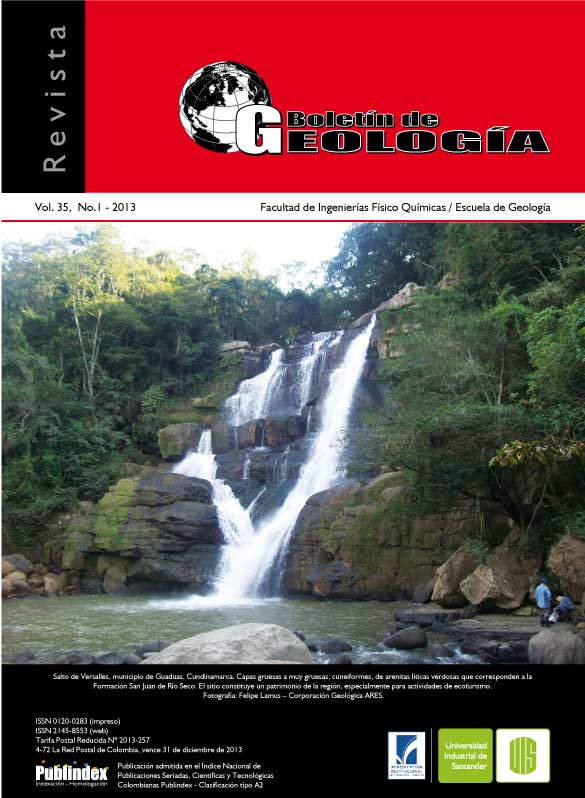PETROGRAPHY, PETROLOGY AND PROVENANCE ANALYSIS OF THE PALEOGENE UNITS FROM CESAR RANCHERÍA AND CATATUMBO BASINS
Published 2013-05-31
How to Cite
Abstract
Cesar - Catatumbo and Ranchería basins are located in the Maracaibo Block, together with the Santander Massif, the Sierra Nevada de Santa Marta, Serranía del Perijá and Andes de Mérida. The determination of detritus composition and provenance in Paleogene stratigraphic units, complement the tectonic understanding of this period. In the upper Paleocene, the compositional inmaturity is relevant in the Cesar-Rancheria Basin, due to high proportion of feldspars and lithic fragments (litharenite and feldespathic litharenite). In the Catatumbo Basin the Paleogene sandstones have more compositional maturity (sublitharenite) predominating quarz fragments, and presence of metamorphic and sedimentary fragments. The three basins are interpreted as the re-working of sedimentary rocks and a metamorphic basement.
The Eocene rocks are different in their composition and lithic components; while the Catatumbo Basin has an increase of the monocrystalline quartz with high feldspars content (lithic feldsarenite and feldespathic litharenite) and metamorphic lithics, in the Cesar Basin the metamorphic lithics are higher with low volcanic fragments presence of similar composition to the Paleocene rocks. The Misoa Formation records a volcanic event, which differentiates it from all other formations. While in the Catatumbo Basin, the Mirador Formation is clearly quartz with high compositional and textural maturity, indicating a difference with the last sandstones. In the upper Eocene the deposit of Carbonera Formation produces sandstones with less compositional maturity, with a feldspar contents of 7,9% varying from lithic feldsarenite to feldsarenite and litharenite.
The constituent similitude of the sandstones links the south part and northern in the Cesar-Rancheria Basin, determining the Santa Martha Massif as the principal source rock. The detritus provenance in the Catatumbo Basin for the Paleocene, is related to the Silgara Formation of Santander Massif, proposing this as the main positive area that provided those sediments. The drastic change between the Paleocene- Eocene with the Mirador Formation gives another source area, which relate with detritus from Guyana Shield. For the uppermost Eocene a new change in the sediment supply is defined, however no stratigraphic record exist, as the sequence of the Carbonera Formation is not complete.
Keywords: Paleogene, Petrography, Petrofacies, Provenance.
Downloads
References
Dickinson, W. 1985. Interpreting provenance relations from detrital modes of sandstones, Zuffa, G.G. Eds. Provenance of Arenites. Reidel Publ., Dordrecht, pp. 333-361,
Escalante, C., y Rojas, L. 1991. Ambientes de depósito de las formaciones Catatumbo y Barco con base a registros eléctricos Cuenca de Catatumbo (Trabajo de grado). Universidad Industrial de Santander, 118p
Fabre, A. 1977. Geología regional de la Sierra Nevada del Cocuy, plancha 137, “El Cocuy”. Departamento de Boyacá e Intendencia de Arauca. INGEOMINAS, Informe N° 1877, pp. 199
Folk, R.L. 1974. Petrology of Sedimentary Rocks, Hemphill Publ. Co, Austin, 182p.
Ingersoll, R.V., Bullard, T.F., Ford, R.L., Grimm, J.P., Pickle, J.D. and Sares, S.W. 1984. The effect of grain size on detrital modes: A test of the Gazzi-Dickinson Point-Counting Method. Journal of Sedimentary Petrology, 54 (1): 103-116.
Johnsson, M.J. 1993. The system controlling the composition of clastic sediments.- Johnsson, M.J. y Basu, A., eds. Processes Controlling the Composition of Clastic Sediments, Geological Society of America Special Paper 284: 1-19
Llerena, J., y Marcano, F. 1997. El sistema petrolífero en la Subcuenca de Catatumbo, Cuenca de Maracaibo, Venezuela. VI Simposio Bolivariano de Cuencas Subandinas, Tomo I, pp. 540.
Taboada, A., Rivera, L., Fuenzalida, A., Rivera, C., Cisternas, A., Philip, H., Bijwaard, H., and Olaya, J. 2000. Geodynamics of the Northern Andes: Subductions and Intracontinental Deformation (Colombia). Tectonics, 19 (5): 787-813.
Tschanz, C., Marvin, R., Cruz, J., Mehnert. H., and Cebula, G. 1974. Geologic Evolution of the Sierra Nevada de Santa Marta, Northeastern Colombia. Geological Society of American Bulletin, 85: 273-284
